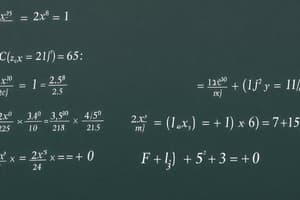Podcast
Questions and Answers
Qual é a ramificação da matemática que se ocupa das relações entre ângulos e comprimentos dos lados de triângulos?
Qual é a ramificação da matemática que se ocupa das relações entre ângulos e comprimentos dos lados de triângulos?
- Trigonometria (correct)
- Cálculo
- Álgebra
- Geometria
Quem foi o matemático que contribuiu para a transformação da trigonometria de uma fundação geometricamente pura para um assunto álgebraico-analítico?
Quem foi o matemático que contribuiu para a transformação da trigonometria de uma fundação geometricamente pura para um assunto álgebraico-analítico?
- Galois
- Pitágoras
- Descartes
- Euler (correct)
Quais civilizações antigas contribuíram para o desenvolvimento da trigonometria?
Quais civilizações antigas contribuíram para o desenvolvimento da trigonometria?
- Gregos e Romanos
- Chineses e Japoneses
- Egípcios, Mesopotâmicos e Indianos (correct)
- Astecas e Incas
Em qual campo a trigonometria é usada para medir distâncias e posições de corpos celestes?
Em qual campo a trigonometria é usada para medir distâncias e posições de corpos celestes?
Qual é a fórmula que expressa as funções trigonométricas em termos de números complexos?
Qual é a fórmula que expressa as funções trigonométricas em termos de números complexos?
Em quais indústrias a trigonometria é usada para determinar distâncias e direções?
Em quais indústrias a trigonometria é usada para determinar distâncias e direções?
Qual é a principal razão pela qual a trigonometria é fundamental em engenharia?
Qual é a principal razão pela qual a trigonometria é fundamental em engenharia?
Quais são as três funções trigonométricas fundamentais?
Quais são as três funções trigonométricas fundamentais?
O que é a principal aplicação da trigonometria em imagens médicas?
O que é a principal aplicação da trigonometria em imagens médicas?
Como se chama a técnica de análise de cenas de crime que utiliza trigonometria?
Como se chama a técnica de análise de cenas de crime que utiliza trigonometria?
Quais são as funções inversas das funções trigonométricas?
Quais são as funções inversas das funções trigonométricas?
Qual é a relação entre a trigonometria e o cálculo?
Qual é a relação entre a trigonometria e o cálculo?
Flashcards are hidden until you start studying
Study Notes
Trigonometry: The Science of Triangles and Angles
Trigonometry is a branch of mathematics that deals with the relationships between angles and the lengths of the sides of triangles. It is a crucial tool in various fields of science and engineering, providing a means to calculate distances, heights, and other measurements based on the angles and sides of triangles.
History of Trigonometry
Trigonometry has its roots in ancient civilizations such as Egypt, Mesopotamia, and India, where it was initially used for astronomical and navigational purposes. The concept of trigonometry was first formalized in the 3rd century BC by Greek mathematicians, who applied it to the study of triangles.
In the 16th century, trigonometry began to shift from its purely geometric foundation to an algebraic-analytic subject. This transformation was driven by the work of mathematicians like Euler, who introduced the Euler's formula, which expresses the trigonometric functions in terms of complex numbers.
Applications of Trigonometry
Trigonometry has a wide range of applications across various scientific and engineering disciplines. Some of its most notable uses include:
-
Navigation: Trigonometry is commonly used in navigation to determine distances and directions, especially in aviation and maritime industries.
-
Astronomy: In astronomy, trigonometry is used to measure the distances and positions of celestial bodies, such as stars and planets.
-
Surveying: Trigonometry is an essential tool for surveyors, who use it to measure distances and calculate heights, angles, and areas of land.
-
Engineering: Trigonometry is applied in engineering to design and analyze structures, such as bridges, buildings, and aircraft.
-
Physics: Trigonometry is used in physics to study the motion of objects and the behavior of waves.
-
Computer Graphics: Trigonometry is used in computer graphics to create 3D models and simulate real-world phenomena, such as light reflection and shadowing.
-
Video Games: Trigonometry is a fundamental component of video games, as it is used to create the physics and mathematics behind game engines.
-
Medical Imaging: Trigonometry is used in medical imaging, such as CT scans and MRI, to create detailed images of the human body.
-
Crime Scene Investigation: Trigonometry is used in forensic science to analyze crime scenes, such as determining the height of a fall or the trajectory of a bullet.
Trigonometric Functions
Trigonometry involves the study of three fundamental functions: sine (sin), cosine (cos), and tangent (tan). These functions relate the angles and sides of a right-angled triangle, with sin(θ) = opposite/hypotenuse, cos(θ) = adjacent/hypotenuse, and tan(θ) = opposite/adjacent.
Inverse Trigonometric Functions
In addition to the standard trigonometric functions, there are inverse functions, such as arcsin, arccos, and arctan, which allow you to find the angle given a sine, cosine, or tangent value.
Trigonometry in a Circle
Trigonometry is not limited to right-angled triangles; it can also be applied to all angles, from 0 to 360 degrees. To understand how the trigonometric functions work with angles greater than 90 degrees, it is helpful to think about triangles constructed within a circle.
Trigonometry and Calculus
Trigonometry and calculus are closely related, with calculus being built upon the principles of trigonometry. Calculus involves the study of functions and their rates of change, and trigonometry provides the foundation for understanding these concepts in terms of triangles and angles.
In conclusion, trigonometry is a versatile and essential tool in mathematics, science, and engineering, with a wide range of applications in various fields. Its study of angles and the relationships between the sides of triangles provides a solid foundation for understanding many complex concepts in mathematics and science.
Studying That Suits You
Use AI to generate personalized quizzes and flashcards to suit your learning preferences.




